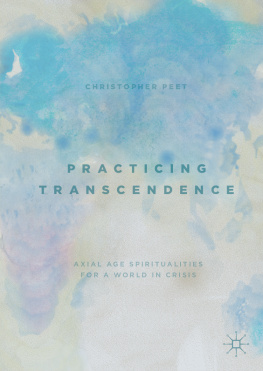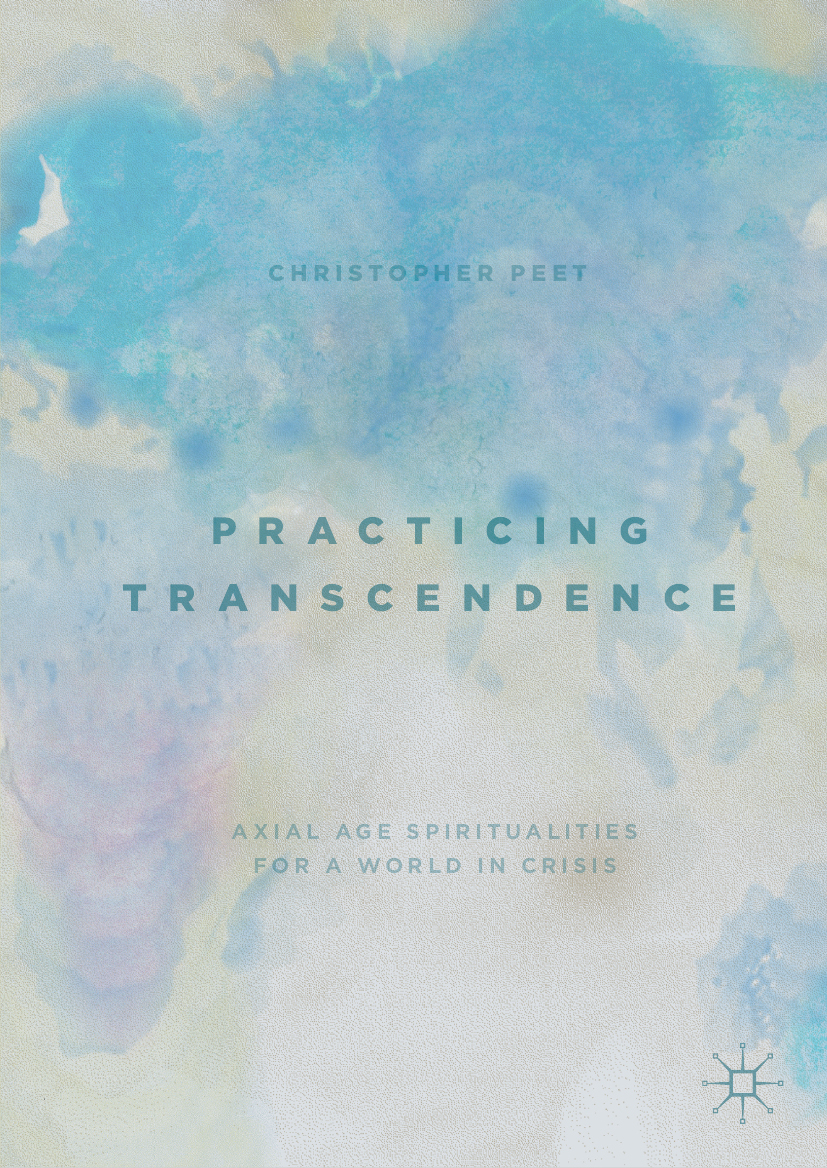Christopher Peet
Practicing Transcendence Axial Age Spiritualities for a World in Crisis
Christopher Peet
The Kings University, Edmonton, AB, Canada
ISBN 978-3-030-14431-9 e-ISBN 978-3-030-14432-6
https://doi.org/10.1007/978-3-030-14432-6
Library of Congress Control Number: 2019932957
The Editor(s) (if applicable) and The Author(s) 2019
This work is subject to copyright. All rights are solely and exclusively licensed by the Publisher, whether the whole or part of the material is concerned, specifically the rights of translation, reprinting, reuse of illustrations, recitation, broadcasting, reproduction on microfilms or in any other physical way, and transmission or information storage and retrieval, electronic adaptation, computer software, or by similar or dissimilar methodology now known or hereafter developed.
The use of general descriptive names, registered names, trademarks, service marks, etc. in this publication does not imply, even in the absence of a specific statement, that such names are exempt from the relevant protective laws and regulations and therefore free for general use.
The publisher, the authors and the editors are safe to assume that the advice and information in this book are believed to be true and accurate at the date of publication. Neither the publisher nor the authors or the editors give a warranty, express or implied, with respect to the material contained herein or for any errors or omissions that may have been made. The publisher remains neutral with regard to jurisdictional claims in published maps and institutional affiliations.
Cover art Axis Time by Alicja Warszynski
Cover design by Tom Howey
This Palgrave Macmillan imprint is published by the registered company Springer Nature Switzerland AG
The registered company address is: Gewerbestrasse 11, 6330 Cham, Switzerland
The greatest merit of Christopher Peets book is that it introduces a new, academically-grounded concept of the Axial Age and its place in world history in a way that is accessible to a wider audience. The general reader and professionals in the humanities and social sciences will equally find this book a really exciting read, a true intellectual journey.
Dmitri M. Bondarenko, Director of the International Center of Anthropology, National Research University, Russia
Christopher Peet has done a remarkable job of bringing together this complex history in lucid prose. He presents a new perspective on the key idea of transcendence that emerged in the axial age, which marks the Axial road not taken, undervalued by Big religion as well as scholars thus far. Most notably, he reveals how transcendence needs to be understood not simply as an idea, but as living spiritual practices bodied forth by visionaries in small communities then, and just as available as vital resources now. The self-transcending self, as the practical aim of a variety of axial spiritual practices, remains a viable and potent path to offset our power-centered civilization today.
Eugene Halton, Professor of Sociology, University of Notre Dame, USA
The Axial Agethe period from 800 B.C.E. to 200 B.C.E., when the religio-philoso-phic foundations of the world religions were createdhas over the past several decades been the subject of a burgeoning literature in history, civilization studies, sociology, and political science. In Practicing Transcendence: Axial Age Spiritualities for a World in Crisis , Christopher Peet provides a masterful synthesis of the now vast literature relating to the Axial Age. His interpretation emphasizes the visionary ways in which figures of the Axial Age in China, India, Israel, and Greece responded to crises in the civilizations of their times. The esteem previously accorded to the famous works of S.N. Eisenstadt and Robert N. Bellah must now be shared with Peets contribution; his work is truly indispensable to future scholarship on the Axial Age. Peet bookends his analysis with an introduction and conclusion highlighting the pertinence of Axial Age visions and practices to the crisis of civilization that we, citizens of global society, experience today with the growing assaults on our shared environment.
Victor Lidz, Professor Emeritus of Sociology, Drexel University College of Medicine, USA
to children and wild things -
by your innocence
we measure our worth
Acknowledgements
Protagoras is credited with saying there are two sides to every story. That has certainly been true for the writing of this book. On the one side, it has been a solitary effort, a despairing meditation, and a long and lonely work. The other side, equally true, is that I could not have done it without friends, family, community, spiritual communities, and professional networks that have supported me throughout.
My scholarly community at The Kings University has been one of constant support and quiet encouragement, and my thanks to my many colleagues there for their generosity and wisdom and for numerous conversations both disciplinary and interdisciplinary. The Western Canadian Theoretical Psychology group has offered context for informal dialogue and regularly recurring conviviality for two decades now for which I am grateful. An unexpected invitation from the Karl Jaspers Society of North America provided me a rare opportunity for collegiality with Axial Age scholars at a conference of the American Philosophical Association that assisted in completing the work; thank you.
Thanks to my community of faith at St. Pauls United for community and communion, and for the same but in a different, more interior way, from the centering prayer group. Thank you for your companionship and hours of good conversationand countless more hours of shared silence. Thanks especially Lynnda, Susan, and Charles for your kindness and guidance on the journey.
Friends and family I mention last because they are not least: my father, who left in the middle, and my mother, who left at the end; Leo, you leave a deep and lasting mark; Sheena and Oliver, your presence has been a blessing; Susan and Dave, always with me in spirit. And above all others, my gratitude to Hannah, Logan, and Tatiana, for bearing with me, and for your love.
My gratitude to all of you. All shortcomings and errors in the book, of course, are mine alone.
Contents
List of Figures
Fig. 1.1 World religions by population (Adapted from Partridge, 2005)
Fig. 2.1 a Gradualist evolution. b Evolution via mass extinction (Adapted from Raup & Sepkoski, 1982, 1984)
Fig. 2.2 World wealth distribution (Adapted from Credit Suisse Global Wealth Report, 2017)
Fig. 3.1 Secondary literature on Axial Age, by decade
Fig. 5.1 Greek philosophers, schools, and dates
1. The Relevance of the Axial Age for a World in Crisis









